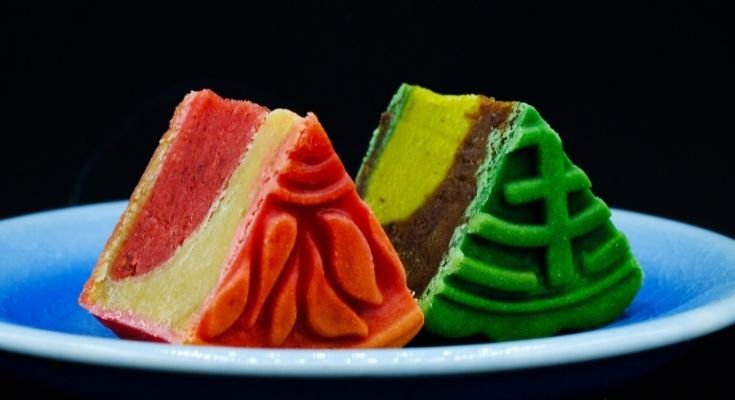Mooncakes hold a special place in the hearts of millions, especially during festive seasons. These delectable treats are an integral part of various cultural celebrations, such as the Mid-Autumn Festival. Their round shape and intricate designs symbolize unity and togetherness among families and communities.

The Origins of Mooncakes
Mooncakes have a long and fascinating history dating back over 3,000 years to ancient China.
They were first created during the Yuan Dynasty and were used as a medium to communicate rebellion plans against the ruling Mongols.
Over time, they evolved into a popular traditional delicacy enjoyed during the Mid-Autumn Festival, which falls on the 15th day of the eighth lunar month.
Mooncakes: A Symbol of Tradition and Celebration
In modern times, mooncakes have become synonymous with celebration and family gatherings.
During the Mid-Autumn Festival, people exchange mooncakes as tokens of love and respect. The act of sharing mooncakes represents unity, harmony, and a sense of completeness.
Mooncake Ingredients and Flavors
Traditional mooncakes are made from a variety of ingredients, with the most common being lotus seed paste and salted duck egg yolks.
The combination of sweet lotus paste and savory egg yolk creates a unique and tantalizing flavor.
However, as the popularity of mooncakes has spread, so have the varieties of flavors. Today, you can find mooncakes filled with red bean paste, black sesame, green tea, durian, and even ice cream!
The Taste and Texture of Mooncakes
The taste of a mooncake depends on the type of filling used. Lotus seed paste mooncakes offer a delightful blend of sweetness and richness, complemented by the subtle saltiness of the egg yolk.
Red bean paste mooncakes provide a smoother and earthier taste, while the nutty and aromatic black sesame mooncakes delight the taste buds with every bite.
Durian mooncakes, for the adventurous souls, boast a strong and distinctive flavor that is both loved and loathed by many.
Regional Variations of Mooncakes
As mooncakes gained popularity worldwide, various regions developed their own unique twists on this traditional treat.
For example, in Malaysia and Singapore, snow skin mooncakes have become a favorite during the Mid-Autumn Festival.
These non-baked mooncakes feature a soft and chewy outer layer, providing a delightful contrast to the fillings inside.
Mooncakes and Festivals Around the World
While mooncakes have deep-rooted associations with Chinese culture, they have transcended borders and become a part of other cultural celebrations.
In Vietnam, mooncakes, known as “bánh trung thu,” are a cherished delicacy during the Mid-Autumn Festival.
Similarly, other Asian communities, such as the Korean and Japanese, have incorporated mooncakes into their festivities.
Making Mooncakes at Home: A Delightful Experience
For those seeking a hands-on experience, making mooncakes at home can be a rewarding and enjoyable activity.
With the right ingredients and tools, you can craft personalized mooncakes with fillings of your choice, allowing for a truly authentic and delightful taste.
Health Benefits and Considerations
While mooncakes are undeniably delicious, it’s essential to consume them in moderation due to their high calorie and sugar content.
Additionally, some mooncakes may contain allergens like nuts or dairy, making it crucial for individuals with dietary restrictions to check the ingredients carefully.
Tips for Pairing Mooncakes
Pairing mooncakes with the right beverages can enhance the overall taste experience. Traditionally, Chinese tea, such as oolong or pu-erh, is served with mooncakes to balance the sweetness.
However, you can experiment with various teas, coffees, or even wines to find the perfect pairing that suits your palate.
Mooncakes: A Symbol of Togetherness and Unity
Beyond their delightful taste, mooncakes symbolize togetherness and unity. The act of sharing mooncakes with family, friends, and colleagues fosters a sense of belonging and strengthens bonds, making them more than just a dessert.
How to Store Mooncakes Properly
To preserve the freshness and taste of mooncakes, it’s essential to store them correctly. Keep them in an airtight container at room temperature, away from direct sunlight and moisture. Alternatively, you can refrigerate them to extend their shelf life.
The Future of Mooncakes
As the world becomes more interconnected, mooncakes will continue to evolve and adapt to global tastes.
Perhaps we’ll witness even more innovative flavors and creative designs in the years to come, making mooncakes a truly universal delight.
FAQs
Mooncakes are traditionally associated with the Mid-Autumn Festival, but they are also enjoyed on other special occasions and festivals.
Freezing mooncakes can alter their texture and taste, so it’s best to consume them within a reasonable time frame.
No, not all mooncakes contain egg yolks. There are various fillings available, and some mooncakes are egg yolk-free.
The round shape symbolizes completeness and reunion, emphasizing the importance of family and togetherness.
Conclusion
In conclusion, mooncakes are not only a delicious treat but also a symbol of tradition, celebration, and togetherness.
Their diverse flavors and textures cater to a wide range of palates, making them an appealing choice for people from all walks of life.
So, the next time you receive a mooncake, savor the moment and cherish the cultural significance that comes with this delectable pastry.
